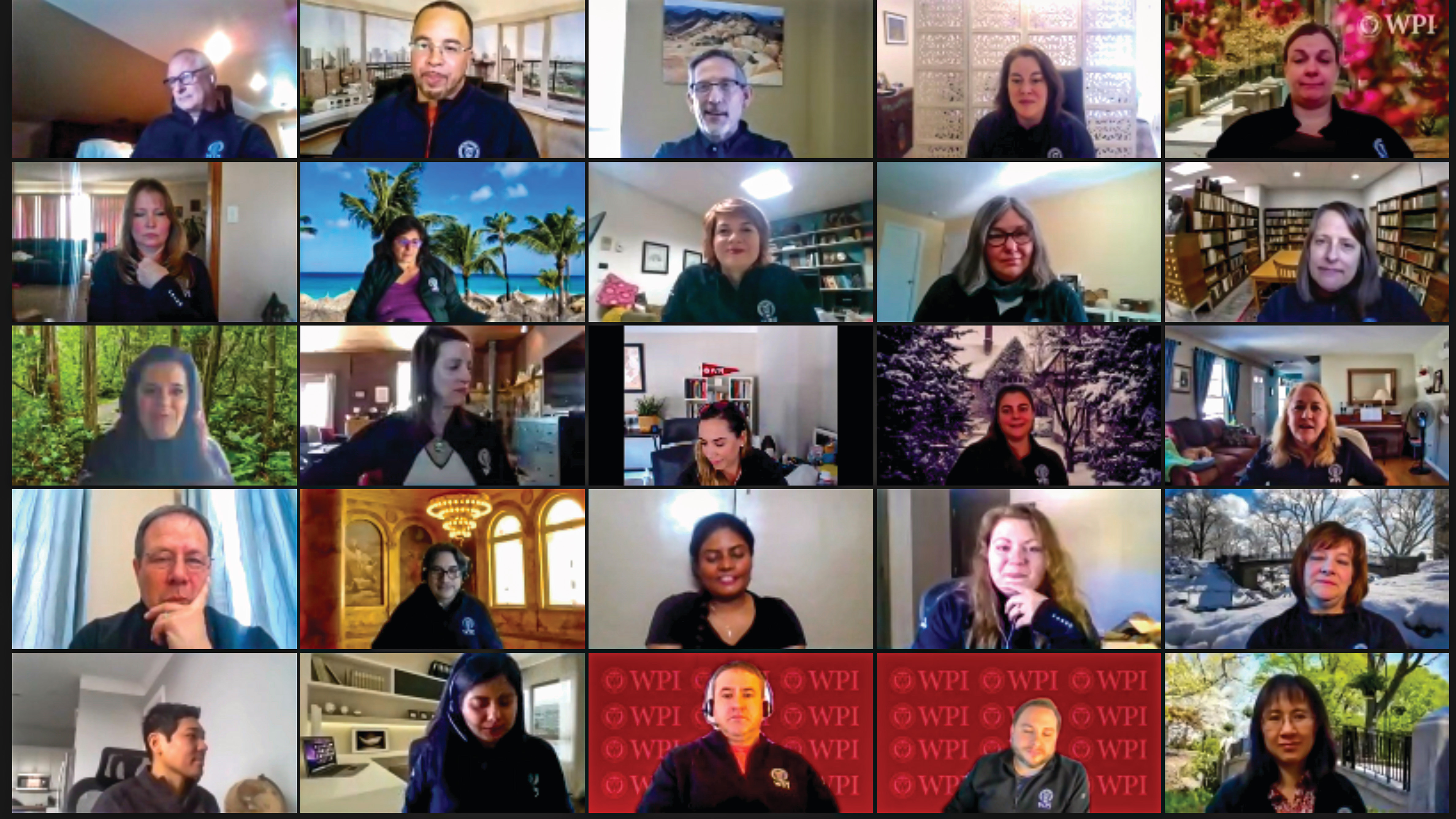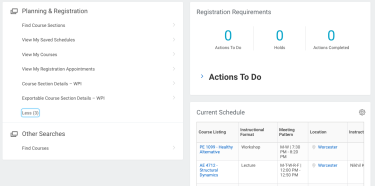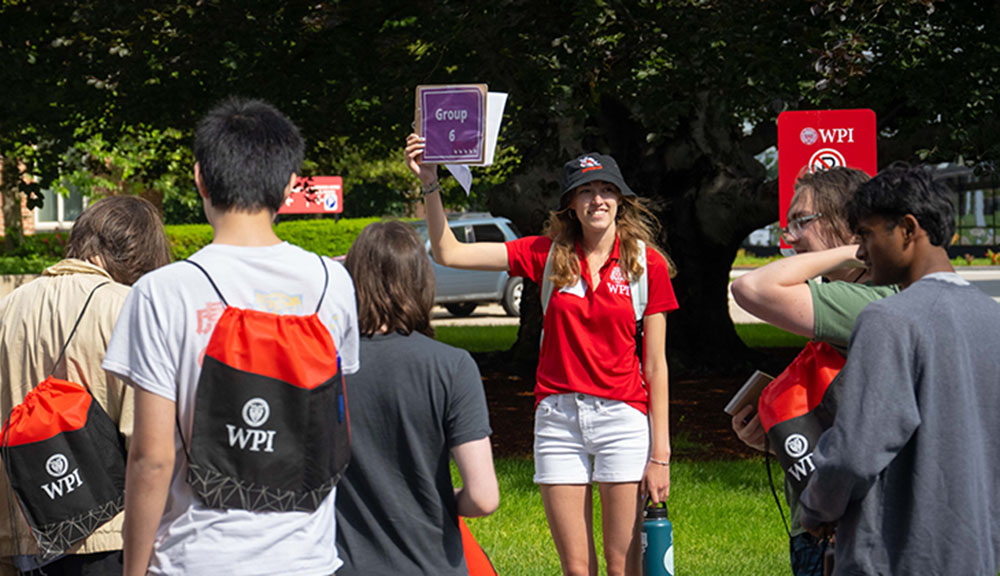Registration for new term/semester classes is always a high-stakes event—getting the right classes in the right times is critical for students. And this year, the registration days for rising seniors, rising juniors, and rising sophomores came with extra pressure—and accomplishment: 3,766 students registered for classes using Workday Student, which will fully replace Banner as the new system of record for student information in the first term/semester of fall 2021.
A production version of Workday Student was made available in the beginning of April to give students a chance to login and get a feel for the course scheduling and registration process ahead of time, before they actually registered in early May. As with any course registration process, there were bumps along the way, but the technology performed as expected—a major step forward on the long, winding, and multi-year journey that is WPI’s Enterprise Transformation Project (ETP).
For WPI’s Workday Student team, including the registrar, bursar, academic affairs, academic advising, and IT—the success was in the teamwork and the attention to detail for both the technological changes and the community training and engagement. Hunkered down at home, across the commonwealth and the country due to COVID-19, WPI employees and consulting project managers and Workday experts from Accenture, Avapp and SharperPoint Consulting Group kept this enormous undertaking on track.
“This project has been an incredible challenge, and the teamwork is invaluable,” says Sarah Miles, registrar, who, along with her team, has provided guidance on how to configure the system for such actions as repeating classes, recording grades, and making policy changes. “We ran into issues, but we worked together to figure out solutions. We have had support from the top and all the way through WPI.”

All Hands on Deck from Start to Finish
As registration approached, the Workday Student project team created an airtight student support plan. Across the three days, students could drop in (virtually) from 7am to 5pm to connect live with supportive staff from academic advising, the registrar’s office, IT, and consultants from Workday, in an all-hands-on-deck approach to solving issues in real time.
There were the typical issues of classes being full and recommendations needed for what classes to take—and ones focused on how to navigate the new system. The first day yielded about 100 student drop-ins and then reduced to between 60 and 80 over the next two days.
“It was really important to create a seamless registration and advising process for students, and having the support in place really made a difference,” says Assistant Dean of Student Success Paul Reilly, who was joined in the day-long virtual sessions by his team of advisors and their administrative assistant.
Lessons Learned
The move from Banner to Workday was a heavy lift in several ways: the need to carry the lessons learned from the launch of Workday for HR and finance; the complexity and quantity of records in play, the reality of adapting from a 30-year-old, highly-modified-for-WPI legacy system to a still-evolving tool, and supporting staff, faculty and students who are using both systems for different functions during the transition.
The team built more waves of development into the Workday Student Schedule, deployed across a longer time period, and liaised regularly with faculty governance. They reviewed and discussed planned changes in advance with deans and key staff members, and gathered input monthly from faculty, staff, and students—strategies that were all based on community feedback after the launch of the HR and Finance aspects of Workday in the fall of 2018.
And while the roadmap was certainly clearer based on lessons learned and processes improved, there were still many days when it “felt like we were tossing luggage from a speeding train onto a parallel moving train,” says Veronica Brandstrader, change management and training manager.
“This project was already a huge challenge, and then Covid hit,” says Brandstrader. There was no time for stopping, and the transition to remote work required a lot more “peering around the bend to anticipate what might come at us next,” she noted, emphasizing her internal and external partners’ incredible resilience and commitment to the project with all of its “issues, risks, reviews, gaps, and blockers. Even with all of these challenges, we were able to make substantial progress because of a cohesive team that cares deeply about the student experience,” said Brandstrader.
Check, Double Check, Validate…
“Mapping the data from Banner to Workday Student was a massive effort,” says Carla Mararian, director of academic affairs technology, the data lead in the Provost’s office. “Workday Student has very specific formatting for how it ingests data, which means each file needed to be created and tested multiple times to be sure there were no errors. We also built validation reports against the Banner data to be sure we weren’t missing anything.”
One unexpected complication was having the academic calendar—which is typically set four years in advance—change twice. This triggered a chain reaction of new tasks to be managed even as the team was meeting daily to make decisions on configuring the new system and cleaning up data, and—as everyone can relate—keeping up with their regular jobs in the midst of a global pandemic.
Ultimately, more than 1.5 million student records were reviewed, cleaned, and moved to Workday Student with a 99.999% accuracy rate.
A New Generation of Technology—and Users
Workday Student is a relatively young product, and WPI’s implementation has played a role in its maturation even as there remains plenty of room for growth. While incorporating data and processes from Banner, Workday Student also connects (or will connect) to other systems integral to the student experience, from admissions and financial aid to registration, advising, grading, and tracking and maintaining all aspects of WPI projects for students, faculty, and sponsors.
Patty Patria, vice president of IT and CIO, says the team fully expects that, in time, WPI students, faculty, and staff will find Workday Student’s function and features a welcome change from cumbersome, sometimes paper-based, steps in past processes. “Whatever the device is in their hands, students, faculty, and staff will be able to log in and get critical tasks done. Students will check their academic records, drop and swap courses, and accept or drop waitlist offerings; faculty can view student records and course rosters and submit grades,” said Patria, who lauded the team for the project outcome and its approach.
The move to Workday Student is aligned with university goals for risk management and a unified digital experience, which values having one source of accurate information and puts the security of systems—and the information they hold—front and center.

Big Changes, Steps at a Time
While there will be some pain of juggling two systems at once (for both users and systems managers), until the transition is complete in Fall 2021, Mararian notes, “The front end of Workday Student is hands down so much better for staff, faculty, and students,” and the feedback from those who’ve been able to use it confirms as much.
Ryan Candy ‘21, president of the Student Government Association (SGA) and mathematical sciences major, agrees that Workday Student has a better user interface and is more intuitive than the legacy system. He also appreciated, as WPI students do, being involved and heard. “I'm very glad that the team has been so eager to get student input throughout the process,” says Candy. “Having conversations, especially the challenging ones, early and often in the process will make the end product that much better.”
Of course, enhancements have been requested and are being evaluated for feasibility and scheduling, including different ways to search, changes to the ways class sections are grouped, and sorting and grading options.
“Once more data features are available in Workday Student in the fall, staff and faculty will be able to generate their own reports,” said Mararian. “The dashboard will display graphs and pie charts of the data such as teaching loads and the number of students by major, helping to aid decision-making on everything from personnel needed to student recruitment.” Features for advising and implementation related to course planning are also expected to streamline work.
Collaboration Key to Success
The Grove Street conference room where the team had worked together for so many months is a distant memory. The transition to working from home was tougher for some members than others. But the one thing that they had in common was empathy and support for each other—wherever they were working.
Jill Desmarais, in her role as the co-project manager for Workday Student, has connected and collaborated with team leaders like clockwork every morning to coordinate ongoing meetings, manage follow up actions, and identify roadblocks. “With a strong team culture and support from our sponsors, we are able to make our production timeline,” she noted. “It’s clear in our online meetings that we have each other’s backs. We have an understanding of the pressure that we’re all under and support each other.”
Bursar Lynn Beauregard, the student finance lead, agrees that the team dynamic and leadership support are the keys to the success of the project. “We’re trying to improve the student and authorized user experience, which is the most important aspects, as well as leverage better technology,” she says. “The team, project managers, and sponsors are amazing and are all focused on ensuring the success of the hard work and dedication of the team.”
“It has been a tremendous honor to work with such a dedicated and talented team,” said Glenn Small, president of SharperPoint Consulting Group, LLC, which provided program management and oversight services. “Especially through a terribly challenging time, the team delivered outstanding results while working entirely remotely.”
John Harrison, managing director of the Workday higher education group at Accenture, agrees. “Collaboration across all our teams resulted in an innovative solution for WPI’s specialized needs around their unique custom-developed project-based curriculum,” he notes. “This was one of those times where lasting relationships were established, based on shared dedication and commitment to a common goal.”
(Editor’s Note: There were tens of employees whose talents and commitment are making ETP and Workday Student a success; those quoted are representative.)



